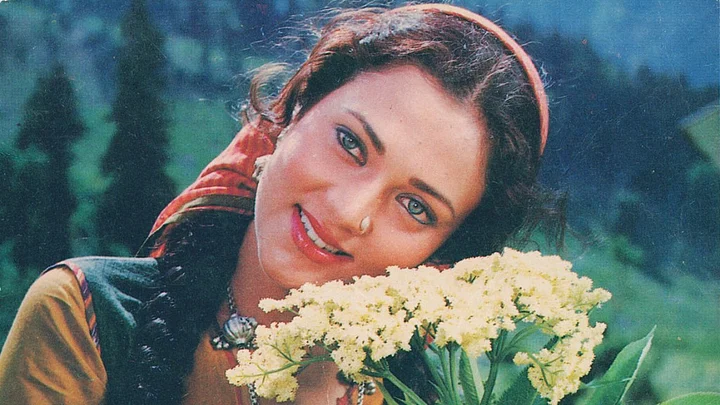“When those who’re alive can do their worst, why should I fear the dead?” she had asked famously in a graveyard scene where, as an unwed mother, she seeks refuge in the dead of the night.
The lacerating dialogue, her frank sexuality in the still-recalled waterfall and breast-feeding scenes, her dance moves to the song Sun Saiba Sun, all conceived and directed by Raj Kapoor for Ram Teri Ganga Maili, were and still are her ticket to fame.
Born Yasmeen Joseph in Meerut to a British father and an Indian mother, for starters she was screen-named Madhuri by a small-time film producer and then altered to Mandakini by the supremo showman.
Raj Kapoor’s search for a newcomer to play the title role of Ganga opposite his son Rajiv Kapoor, was one of those twists of Bollywood fate.
The Bobby heroine, Dimple Kapadia had been auditioned for the role of Ganga. The clip was shown on Doordarshan, as part of the footage for a portrait on Raj Kapoor made by Ramesh Sharma. Viewers across the nation gasped. Dimple looked great, acted perfectly for the audition. The showman wasn’t sure, he believed a newcomer was the answer to project the innocence and guilelessness of a pahadi girl who must endure travails of the lachrymose kind, following love interrupted with a shehari babu.
Now that was 32 years ago. I’m recalling the RK heroine since she turns 54 years old today, and has opted to lead “a normal life” on Mumbai’s Yari Road, Andheri, with her husband Dr Kagyur T Rinpoche Thakur. Together they run the Tibetan Herbal Centre. An all’s-well, that ends-well-wrap, it would seem. She’s been largely forgotten. After all, it’s out-of-sight-out-of-the-radar in showbiz.
That Mandakini was a one-film wonder could be debated (mildly). After all, in a little over a decade she did fetch up in as many as 40 films, B Subhash’s Dance Dance (1987) in which she sought to keep pace with Mithun Chakraborty’s mambo moves, and a cameo in N Chandra’s Tezaab (1988).
But think Mandakini and you think of that wet and wonderful waterfall splash of Ram Teri Ganga Maili. A boffo hit, the film did have its share of carping Cassandras, tsk tsking ‘the titillating, vulgar nudity.’
To this Raj Kapoor had shrugged, “If Federico Fellini shows nude women in Amarcord, it is called art and wins awards at premium festivals. If I dare to go towards nudity, it is called exploitation and voyeuristic.”
Did she have any qualms about the Maili act? On meeting her at a dubbing session of Aag aur Shola (1986) – a mega-melodrama top-lining Jeetendra and Sridevi — I found the new sensation to be either tongue-tied or clever. All questions were deflected with a, “I don’t know ji,”, “Who would dare to disobey Raj Kapoor ji?” and “That’s not a nice question ji.”
She refused to talk about how many times and why she had been rejected by filmmakers or refer to producer Ranjit Wirk who had pencilled her in for Mazloom, only to be nixed from the project when the call came from RK Studio.
As for any comments on Kumar Gaurav who had refused to act with her in the period romance Shirin Farhad, again there was a, “Why get into all that ji?”
My interviewee looked at me as if I were cuckoo or a troublemaker, or both. Throughout, a teenage boy in a fire-engine red T-shirt (if I remember correctly) hovered over us. She said, “That’s my cousin”, smiled generously and asked me to see the rushes of a wetter-than-wet song-and-dance, Barsa re barsa, performed in the company of newcomer Aashish Chanana. Wrigglefest over, lights on, and she enthused, “Nice, no?” Interview finito.
Doubtlessly, the story of her tryst with Bollywood isn’t quite in the league of her reported liaison with Dawood Ibrahim. Now that’s rich material for a biopic about how a movie heroine ventured into the Underworld.
And it’s no secret that the story was scripted quite overtly for the Milan Luthria-directed gangsta flick Once Upon a Time in Mumbai Dobarra! (2013), with Akshay Kumar and Sonakshi Sinha as the feverishly fictionalised versions of you-know-who.
It goes without saying that Mandakini has denied the liaison vehemently. If her photos with Dawood Ibrahim at his special enclosure on the Sharjah cricket grounds were splashed in the newspapers, that wasn’t sufficient proof of the allegations. No she hadn’t married the don, no they weren’t parents of a child. At most she had met him, like many other Bollywood personalities did during their visits to the Gulf countries. Given the benefit of doubt, the story rests there.
Her pre-disappearing-act films – Zordaar (1996), Taqdeer ka Tamasha (1990) and Pyaar ke Naam Qurbaan (1990) - to put it politely, are hardly memorable. A comeback bid, as a singer, with the pop music albums No Vacancy and Shambala, went pffft.
So what do I take away from the ajeeb dastaan of Mandakini, an RK heroine who could have been a queen or at least a princess of the marquee? Answer: here’s a woman who has experienced tremendous highs and lows. And her best policy has been to stymy the Nosy Parkers with a, “That’s not a nice question, ji.”
(The writer is a film critic, filmmaker, theatre director and a weekend painter)
(We all love to express ourselves, but how often do we do it in our mother tongue? Here's your chance! This Independence Day, khul ke bol with BOL – Love your Bhasha. Sing, write, perform, spew poetry – whatever you like – in your mother tongue. Send us your BOL at bol@thequint.com or WhatsApp it to 9910181818.)
(At The Quint, we question everything. Play an active role in shaping our journalism by becoming a member today.)
